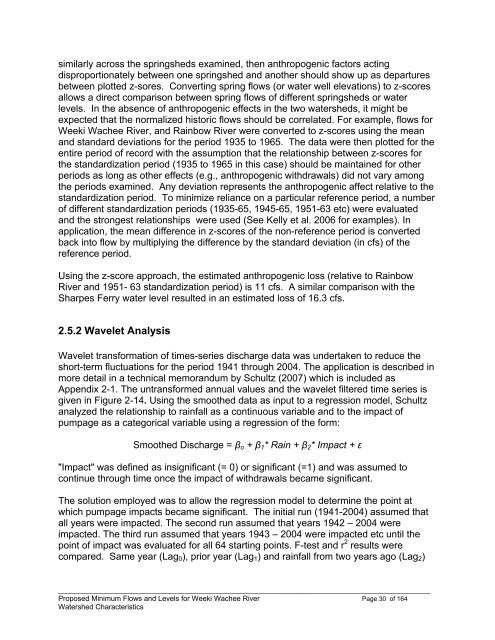Weeki Wachee River System Recommended Minimum Flows and ...
Weeki Wachee River System Recommended Minimum Flows and ...
Weeki Wachee River System Recommended Minimum Flows and ...
You also want an ePaper? Increase the reach of your titles
YUMPU automatically turns print PDFs into web optimized ePapers that Google loves.
similarly across the springsheds examined, then anthropogenic factors acting<br />
disproportionately between one springshed <strong>and</strong> another should show up as departures<br />
between plotted z-sores. Converting spring flows (or water well elevations) to z-scores<br />
allows a direct comparison between spring flows of different springsheds or water<br />
levels. In the absence of anthropogenic effects in the two watersheds, it might be<br />
expected that the normalized historic flows should be correlated. For example, flows for<br />
<strong>Weeki</strong> <strong>Wachee</strong> <strong>River</strong>, <strong>and</strong> Rainbow <strong>River</strong> were converted to z-scores using the mean<br />
<strong>and</strong> st<strong>and</strong>ard deviations for the period 1935 to 1965. The data were then plotted for the<br />
entire period of record with the assumption that the relationship between z-scores for<br />
the st<strong>and</strong>ardization period (1935 to 1965 in this case) should be maintained for other<br />
periods as long as other effects (e.g., anthropogenic withdrawals) did not vary among<br />
the periods examined. Any deviation represents the anthropogenic affect relative to the<br />
st<strong>and</strong>ardization period. To minimize reliance on a particular reference period, a number<br />
of different st<strong>and</strong>ardization periods (1935-65, 1945-65, 1951-63 etc) were evaluated<br />
<strong>and</strong> the strongest relationships were used (See Kelly et al. 2006 for examples). In<br />
application, the mean difference in z-scores of the non-reference period is converted<br />
back into flow by multiplying the difference by the st<strong>and</strong>ard deviation (in cfs) of the<br />
reference period.<br />
Using the z-score approach, the estimated anthropogenic loss (relative to Rainbow<br />
<strong>River</strong> <strong>and</strong> 1951- 63 st<strong>and</strong>ardization period) is 11 cfs. A similar comparison with the<br />
Sharpes Ferry water level resulted in an estimated loss of 16.3 cfs.<br />
2.5.2 Wavelet Analysis<br />
Wavelet transformation of times-series discharge data was undertaken to reduce the<br />
short-term fluctuations for the period 1941 through 2004. The application is described in<br />
more detail in a technical memor<strong>and</strong>um by Schultz (2007) which is included as<br />
Appendix 2-1. The untransformed annual values <strong>and</strong> the wavelet filtered time series is<br />
given in Figure 2-14. Using the smoothed data as input to a regression model, Schultz<br />
analyzed the relationship to rainfall as a continuous variable <strong>and</strong> to the impact of<br />
pumpage as a categorical variable using a regression of the form:<br />
Smoothed Discharge = β o + β 1 * Rain + β 2 * Impact + ε<br />
"Impact" was defined as insignificant (= 0) or significant (=1) <strong>and</strong> was assumed to<br />
continue through time once the impact of withdrawals became significant.<br />
The solution employed was to allow the regression model to determine the point at<br />
which pumpage impacts became significant. The initial run (1941-2004) assumed that<br />
all years were impacted. The second run assumed that years 1942 – 2004 were<br />
impacted. The third run assumed that years 1943 – 2004 were impacted etc until the<br />
point of impact was evaluated for all 64 starting points. F-test <strong>and</strong> r 2 results were<br />
compared. Same year (Lag 0 ), prior year (Lag 1 ) <strong>and</strong> rainfall from two years ago (Lag 2 )<br />
____________________________________________________________________________________________<br />
Proposed <strong>Minimum</strong> <strong>Flows</strong> <strong>and</strong> Levels for <strong>Weeki</strong> <strong>Wachee</strong> <strong>River</strong> Page 30 of 164<br />
Watershed Characteristics
















